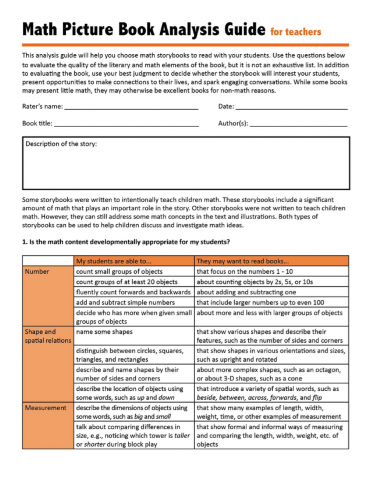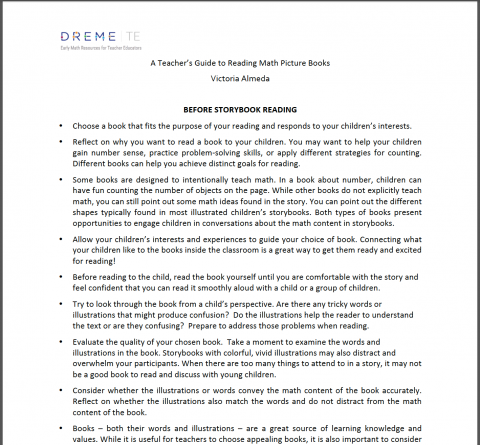This piece discusses general principles of reading and analyzing storybooks, and offers brief descriptions of picture books. It describes how to use the Math Picture Book Analysis Guide with pre-service or in-service teachers.
by Colleen Uscianowski, Colleen Oppenzato, Victoria Almeda, and Herbert P. Ginsburg
Activity for Teacher Educators
If you ask your participants to think about resources for teaching math to young children, they may not suggest picture books. However, just as picture books provide opportunities to develop literacy, they can also be used to promote children's mathematical thinking.
When discussing how to use picture books to teach math, it is important to make a distinction between three types of books: those in which math is explicit, those in which math is implicit, and everything else.
Explicit math books are written for the express purpose of teaching children math. These may even contain a reference to mathematical concepts in their titles, as in the case of books such as Mouse Shapes by Ellen Stoll Walsh. But other books that also explicitly teach math concepts do not have such titles. For example, Hippos Go Berserk by Sandra Boyton, is actually a counting book, but you would not know that from the title.
Other picture books do not explicitly address math, yet the text and illustrations do afford students opportunities to learn about math concepts. A well-known example is Goldilocks and the Three Bears, in which the story involves size comparisons. For example, Papa Bear is the biggest, Mama Bear is medium-sized, and Baby Bear is the smallest. While your participants may not think of Goldilocks as a math story, significant math ideas are implicit in it and important to the plot. Your participants can learn how to use both implicit and explicit math picture books to help children discuss and investigate math ideas.
Finally, we have the rather large category of everything else, that is, books that are not written to teach math and which do not contain significant implicit math. Every picture book page has objects arranged in space, an adult reader can always ask the child to count them, or talk about their location (for example, “The hat is on top of his head”). In other words, adults can interject math conversation in all children’s picture books because “math is all around us.” At the same time, we should not ruin an interesting story by interjecting math to the point of distracting attention from the story line.
Introduction to Picture Book Analysis
An effective way to analyze picture books with participants is to read a picture book together as a whole-group activity. Although they will ultimately be presented with a guide to help them analyze books on their own, this first introduction can be less structured. In this example, we focus on counting.
To promote participants' learning about the qualities of books that lend themselves to math conversation, use a good book that also has some text or illustrations that may be confusing or especially challenging for young children. The book should be one well worth reading and should have many positive qualities, such as an interesting story. At the same time, the book should also include problematic text or illustrations that will provide opportunities for interesting group discussion.
Consider just this two-page spread from the counting book Ten Little Fish by Audrey Wood.
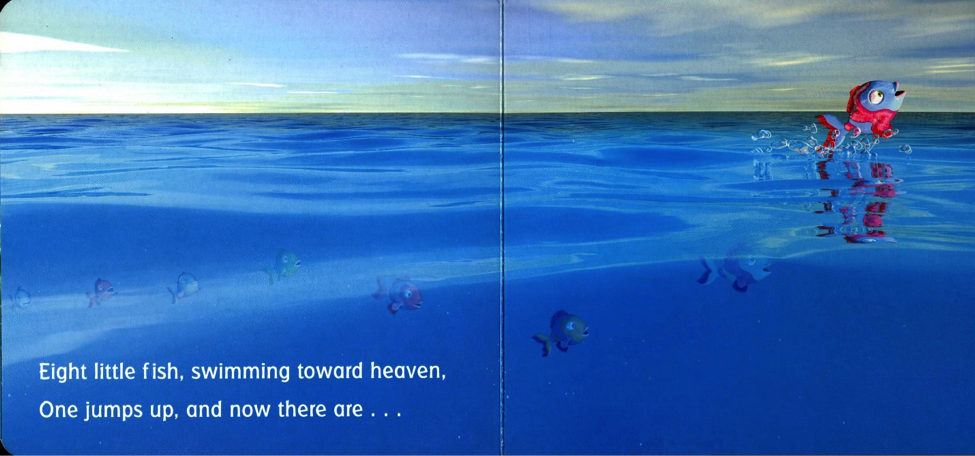
The illustrations in this book are colorful, beautiful and intricate. The text explains that there are eight fish and if you count them, there are. However, the fish on the left are meant to be deeper underwater. So, they are drawn smaller. They are also somewhat obscured by the light hitting the water. So, a very young child might have a hard time seeing and counting the fish on the left, even though they are swimming in a line.
In addition, the text indicates that as one of the eight fish jumps out of the water, there are now only seven fish remaining in the water. However, all eight fish are still clearly visible. It may be hard for a child to understand that the number seven only refers to those underwater. This is still an interesting book, but it might be a better choice for children who are already good counters to teach them about simple subtraction. This might not be the best choice for young children just learning to count objects. There are many books with objects that are more easily countable.
Math Picture Book Analysis Guide
After participants have analyzed a picture book together, introduce the Math Picture Book Analysis Guide (download below). This guide will help participants analyze any book and determine its suitability and usefulness for teaching math to children.
For example, the first question in the Math Picture Book Analysis Guide, shown below, helps a participant determine if a particular book is developmentally appropriate. It suggests that if children can count already fluently count forwards and backwards, a book about adding and subtracting by one might be more appropriate. If you used the two-page spread from Ten Little Fish, shown above, you could point out that this book could be appropriate as a counting backward book or a subtraction book. Other questions in the Math Picture Book Analysis Guide will help participants determine which books might be well suited to the children they teach.

Go through the other questions in the guide with participants. For example, you can present the two-page spread from Balancing Act by Ellen Stoll Walsh, which is shown below. In this book, two mice each stand on one side of the stick and were balanced. This page shows what happens when a salamander wants to join.
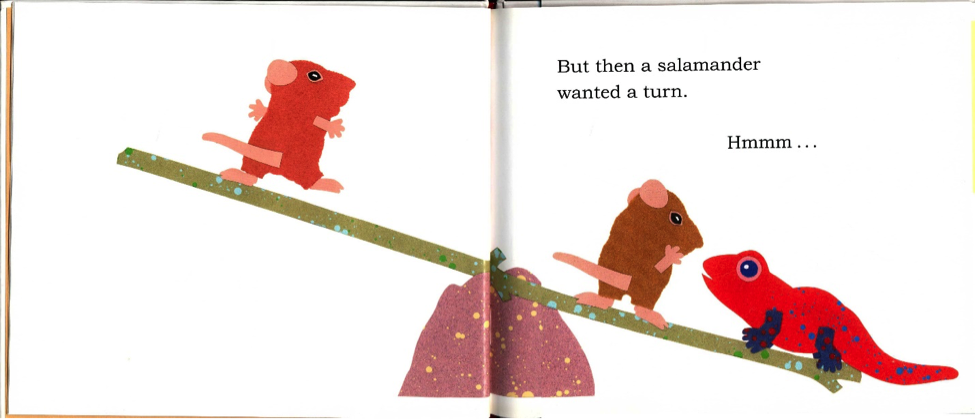
Show how questions 2 and 5 from the guide could be used to analyze a book like this. Start with question 2, shown below.
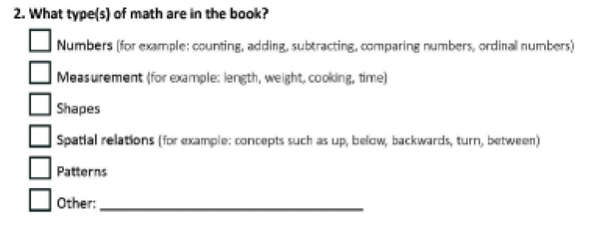
Balancing Act is about measurement. The stick with animals on either side is like a balance scale and as animals jump onto either side, the weight on that side changes. Participants might also check “Other” saying that this book involves ideas of equivalence and nonequivalence.
Next, ask the participants to consider question 3.

Point out that unlike Ten Little Fish, which encouraged the child to count objects, Balancing Act shows measurement in a more general way. Neither weights nor scales are explicitly mentioned, but it is clear that the changing weights are causing the stick not to balance. Move on to question 4.

Many children can relate to the idea of balancing. For example, they may also have used see-saws at playgrounds or they may talk about a time when they had to put their arms out to balance while walking along a log. They may be familiar with weights, pointing out that they have seen weights on packages at the grocery store or they have seen their pets get weighed at the vet’s office. Participants can suggest activities that would incorporate ideas of balance and weight. For example, some preschool classrooms have balance scales that allow children to put different different objects on each side to see what happens.
Finally, discuss question 5.

In a book like Balancing Act, the illustrations from page to page show what happens as more and more animals jump on. It accurately shows the math content, but does not explicitly mention math.
Trying Out the Guide and Annotating Books
Next, break the participants into small groups to analyze some picture books using the Math Picture Book Analysis Guide as you did as a whole group. Encourage them to check off boxes for each question and write comments.
Have participants annotate the picture books using sticky notes. On the first page, make general notes about the book and its usefulness. Annotations for individual pages may include notes about the specific math found on the page, vocabulary (math or otherwise), general reactions or feelings about the book, as well as questions that a teacher might ask a child while reading. Here are some possible annotations for the Balancing Act spread.
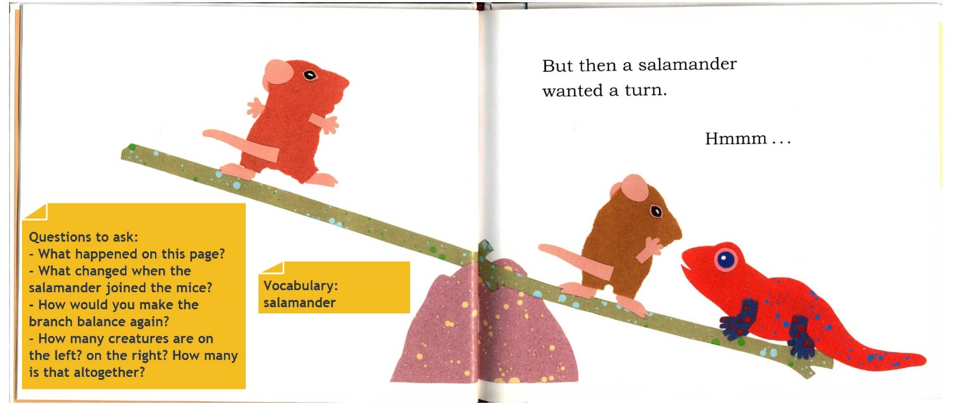
More detailed descriptions of how to annotate specific math books can be found in the Using Picture Books activities in the content modules. It is important to note, however, that only a small number of these questions should actually be used while reading. Pausing for too long and asking too many questions can easily frustrate children who are engaged in the story and eager to see what happens next.
Interactive Reading
Finally, after analyzing books, participants can select a picture book about a specific topic. Have them plan a lesson around the book.
Emphasize that reading books with math content is in many respects no different from reading other books. In both cases, the primary goal is to enjoy and learn from the books. Also, in both cases, the adult reader should employ interactive reading (similar to dialogic reading, that is, reading that engages adult and child in a conversation around reading): The adult asks questions about the book, encourages the child’s attention and participation, and in general takes the child on an intellectual adventure. Most likely, your participants will have studied interactive reading in classes on literacy, but if not, A Teacher's Guide to Reading Math Picture Books (download below) presents the major principles of interactive reading in the context of picture books with significant focus on math.
Conclusion
Picture books afford many opportunities to explore children's mathematical thinking. This is true of explicit math books as well as books in which significant math is implicit. The Math Analysis Picture Guide and the other picture book resources mentioned across our modules can help participants analyze and select picture books effectively and use them to teach math concepts.
Check out our Using Picture Books resources for Counting, Shape & Spatial Relations, Addition & Subtraction, Patterns, and Measurement.

